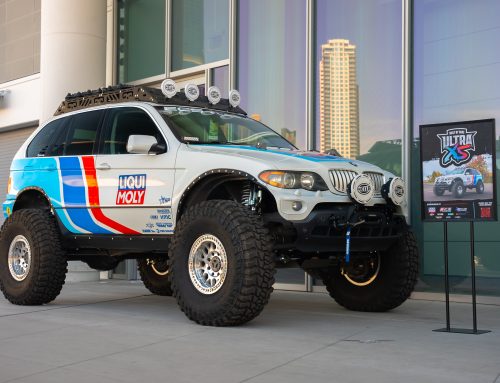Summer is coming to a close and the fall air is drawing near, especially if you live up North. Some cars are put away for the winter and the trusty old beater is awoken once again to take the brunt of the salt and weather damage, while other cars are prepared for winter conditions. Driving a dedicated beater is an excellent option for tackling the winter weather, but for most people, the car they drive every day is the one they continue to drive through the cold months. If you are driving your daily through the winter, there are a few things we recommend that can make those commutes as easy as possible for you.
Some of these tips could be considered obvious if your whole life has been spent above the snow belt. If you are like me and grew up in the warm and sunny south, or if this is the first car that you cared to prepare for winter driving, then this article will help you better outfit your vehicle for the conditions and prevent any premature wear. At the end of the article, we have prepared a checklist for you to print and follow to tackle all of the major concerns associated with winter driving.
Basic Maintenance
Before we run out of balmy afternoons, we need to address any maintenance issues our cars may have. Basic maintenance, the ever important mainstay of car ownership, is key. When the weather turns cold, no one wants to spend hours in their driveway, unheated garage, or worse, the side of the road trying to fix something they could have when it was warm. This is a great time to check your brake pads, rotors, lines, and fluids. If you notice your brakes are nearing the end of their life or the brake fluid is more than two years old, we highly suggest you take care of replacing those with either OEM equivalents or with high-quality aftermarket parts. Definitely check the condition of your brake lines, too. Cracked or worn lines can cause brake biasing if they collapse. Braided steel lines are an excellent upgraded option, or you can go with OEM equivalents.
Battery
Your battery is the easiest thing to swap and also the first component that needs to work in order for your engine to turn on. If your CCA (cold crank amps) are not high enough for the temperature range in which you live, you will need to buy a bigger battery with high a high enough CCA rating to handle a completely cold start in frigid temperatures. If you are like me and moved from the South, this is something you will most likely need to do. If you have a battery with an acceptable rating but notice it is not quite what it once was, check the date on the battery. An old battery will have lost many of its original properties and may behave like a smaller, lower-quality, battery. Replace yours if you think it may be old and tired.
Suspension
Check your tie rods, end links, sway bar bushings, strut mounts, shock mounts, suspension bushings, and dampers. Your suspension will help your car handle through the rougher conditions and will make the car predictable should you encounter hairy situations. Worn out suspension will be floaty, bouncy, clunky, and less than enjoyable, so this is the best time to go ahead and take care of it all at once should it need to be replaced anyway.
Fluids
After brakes and suspension, we also suggest that you knock out anything that might annoy you through the winter. If your car has a leak of any kind, it is a good idea to take care of it in the warm days we have left rather than gamble that it won’t become worse through the winter. This is a fantastic time to also change your oil, check your coolant level, and also inspect your power steering fluid.
Oil
If you live in an area where temperatures drop below 20 degrees Fahrenheit, ensure that the oil weight your car takes will effectively lubricate your engine on a cold start in those conditions. Often, manufacturers list a different cold viscosity (the first number in oil weights) that you can use to better oil your engine in freezing temperatures. Go ahead and give your car a fresh oil change with the manufacturer recommended viscosity so you don’t have to wait on cold oil to plop its way into your drain pan on a dark and snowy night later in the winter. Check out LIQUI MOLY oils and additives for the best lubrication technology available for your car.
Coolant
Coolant is important because it regulates the temperature of your engine as well as provides the heat exchange for your climate control. If your coolant is low, that means you have a leak and may not have enough coolant to allow your heater core to provide that sweet, sweet, warm air in your car. The obvious solution for a leak will be to locate the source of the drip and replace the part. This could be anything from a loose hose clamp or busted hose to a water pump gasket or blown head gasket, so approach any coolant leak seriously and immediately.
Power Steering
Just make sure it is full and not leaking profusely. This system isn’t critical, but it definitely makes driving much easier. If you have to constantly top off your power steering through the winter, you will definitely have a bad time. Look at the reservoir for signs of dripping down the lines as well as the banjo bolts on the steering rack. These, as well as the boots on your steering rack, are the common leak points. Replace lines, washers, and banjo bolts at your discretion.
Scan Tools
It is an excellent choice to purchase a scan tool of some kind. If your car has a check engine light on from a fault code, the scan tool is the only way to find out what that code is. You can take your car to a parts store and use theirs, but who wants to go anywhere in the cold? You can also have a shop or dealership diagnose your faults, but that costs money. Go ahead and buy a scan tool so you can monitor all your important engine functions and save money in the long run for future diagnostics. The scan tools available range from professional grade tools to basic OBD readers. Carista, OBDEleven, and Schwaben Scan Tools are all perfect choices to both code functions and diagnose issues. This tool will provide the important information you need to fix your car now before the days become too dreary.
Tires and Wipers
If you were smart and took care of all your maintenance for cold weather during the last warm days of summer and fall, then you will have little to purchase during the winter to outfit your car. The last things to do before the snow starts to fall will be winter tires and fresh wipers. Winter tires are the best choice for anyone who lives where it snows with any regularity as they will increase your traction and decrease stopping distances for the safest winter driving. New wipers are almost equally as important as they will need to deal with excessive precipitation throughout the winter. If your wipers are streaking, hopping, or bare metal on your windshield, you should replace them for your OCD’s sake.
Interior
Finally, the easy products that will keep you happy this winter are just as critical as all those maintenance jobs. Keeping a jump box, quality ice scraper, and all weather floor mats in the car will be a world of difference as you use the car on a daily basis. No one likes to scrape ice with a credit card, so invest in a scraper with a brush to quickly knock that snow off of your windows and roof. Remember, packed snow on top of your car is a hazard to other drivers, so clear it off! Additionally, if you were more confident in your battery’s abilities than it actually has, a jump box can keep you from freezing off your fingers while you wait for a tow. The Schwaben Micro Jump Start is a handy and compact device that will easily jump most cars and get you on the road to a parts store for a better battery. Lastly, WeatherTech all-weather mats will keep snow, mud, ice, salt, and other grime out of your precious interior with ease. These mats help prevent all that stuff from building up in your carpet and ruining your interior.
If you followed this list in its entirety, then you will have a much easier time this winter driving your daily without worry. The road grime, salt, and snow make for less than desirable driving conditions, but these tips will make sure your car is ready to tackle the weather head-on with confidence. When you are driving your car this winter, remember to be safe and never get into a situation you aren’t sure you can get out of without a tow. Stay warm, keep your car happy, and have fun!
Checklist:
Battery – Cold Crank Amp rating
Brakes – New/like new condition, new brake fluid, brake lines
Suspension – Struts, shocks, mounts, bushings, end links, ball joints
Oil – Oil change (check cold viscosity rating in your owner’s manual)
Coolant – check level and inspect for leaks. Check heat.
Power Steering – Check level and check for leaks
Tires – Snow tires on spare wheels or stocks
Wipers – Get new ones
Interior – WeatherTech mats, Schwaben Micro Jump Box, Ice Scraper with Brush






